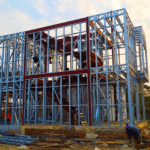How Prefabricated Structures Save Time and Money on Construction Projects?

In the construction industry, time and budget are often the most critical factors determining a project’s success. Prefabricated structures have emerged as a game-changer, offering significant savings in both areas. Here’s how prefabrication is revolutionizing the way we build:
1. Faster Construction Process
Parallel Workflows
Unlike traditional construction, where most activities occur sequentially, prefabrication allows multiple processes to happen simultaneously. While the foundation is being prepared on-site, structural components are manufactured in a factory. This overlap significantly reduces overall project timelines.
Weather Independence
Traditional construction often faces delays due to adverse weather conditions. Prefabricated components are manufactured in controlled environments, ensuring uninterrupted progress regardless of the weather.
Efficient Assembly
Prefabricated components arrive at the construction site ready to be assembled. This minimizes labor-intensive tasks like bricklaying, reducing on-site work time by up to 50%.
2. Lower Labor Costs
Reduced On-Site Workforce
Prefabrication requires fewer workers on-site, as most of the construction is completed in the factory. This leads to lower labor costs and reduced expenses for accommodations, transport, and supervision.
Minimized Errors
Factory-controlled environments ensure precision and consistency in the manufacturing process, reducing costly on-site errors and rework.
3. Material Efficiency
Minimized Wastage
In traditional construction, material waste can account for up to 30% of the total project cost. Prefabrication uses advanced machinery to cut components precisely, significantly reducing wastage.
Bulk Procurement
Manufacturers of prefabricated components often buy raw materials in bulk, reducing costs through economies of scale and passing the savings on to clients.
4. Shortened Financing Costs
Faster project completion means shorter loan durations, reducing interest costs for developers and contractors. For large-scale projects, even a few months saved can translate to significant financial benefits.
5. Energy Savings During Construction
Since prefabrication minimizes on-site machinery use and human activity, energy consumption during construction is considerably lower. These savings contribute to the overall cost efficiency of the project.
6. Predictable Budgets and Timelines
With prefabrication, costs and schedules are easier to predict. The controlled manufacturing process reduces unexpected expenses, while shorter timelines mean fewer chances of going over budget due to extended project durations.
Case in Point
A commercial office building project in the UK opted for prefabricated steel framing and panels. The result? Construction was completed 30% faster, with a 20% reduction in costs compared to traditional methods.
Conclusion
Prefabrication offers a win-win solution for contractors and developers by addressing two of the most pressing challenges in construction: time and money. Its ability to deliver faster, more cost-effective, and high-quality results makes it an indispensable choice for modern construction projects.
Ready to explore how prefabrication can transform your next project? Let’s discuss your vision today!






















